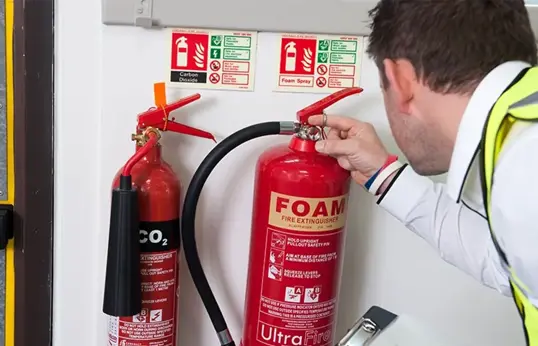Alice worked as a first aid trainer for more than ten years before transitioning into product management and joining the senior leadership team at Red Cross Training.
How fire safety regulations impact the workplace

Find out about the important aspects of how fire safety regulations impact a workplace and understand the important actions to take.
Organisations in the UK must abide by fire safety legislation. Fire safety legislation places the responsibility on individuals within an organisation to carry out risk assessments to identify, manage and reduce the risk of fire.
Fire safety legislation in the UK includes:
- The Regulatory Reform (Fire Safety) Order 2005 (England and Wales)
- Fire Safety (Scotland) Act 2005
- The Fire Safety Regulations (Northern Ireland) 2010
Fire safety legislation applies to all workplaces, such as warehouses, restaurants, construction sites and offices. This blog will help give you an overview of the regulation's impact on employers and how to ensure compliance.
What are the fire safety regulations?
The fire safety regulations are a list of rules that businesses and organisations must follow to remain fire safety compliant. These precautionary regulations are designed to minimise risk in the workplace and keep employees safe, such as:
- Every workplace must carry out a Fire Risk Assessment and take reasonable steps to remove or reduce the risks.
- Plans must be in place for serious and imminent danger. This should include safety drills and evacuation plans and procedures.
- The workplace must have appropriate equipment for firefighting and detection.
- One or more competent persons should be appointed to assist in managing fire safety e.g., fire wardens or fire marshals.
- Tests, maintenance and safety training records must be kept; a Fire Safety and Maintenance logbook is one way of doing this.
Failure to comply with fire safety regulation can result in serious consequences, including sizeable fines and prosecution.
Find out more about fire safety regulations on our Fire Marshal training course
Who is responsible for fire safety in the workplace?
The overall responsibility for complying with the legislation sits with the 'responsible person'. This will normally be the employer and or any other person who may have control of any part of the workplace e.g., the owner, occupier, landlord or managing agent.
Fire safety requirements and the number of people responsible may differ between workplaces due to various fire hazards and risk levels. For example, a construction site may hold a lot of combustible material; restaurants present a range of fire hazards in the kitchen; and offices may contain faulty electrical equipment.
How many fire marshals should be appointed in a workplace?
According to fire safety regulations, employers must appoint at least one competent person to assist in managing fire safety. These individuals are commonly known as fire marshals or can be referred to as a fire warden. What is important is that the designated individuals have received quality training to be able to perform actions in-line with their fire risk assessment and procedures.
Fire safety equipment in the workplace
The workplace must have appropriate equipment for firefighting and detection. This should consider the size and layout of the workplace, any equipment contained, any physical and chemical properties, and the maximum number of people in the environment at any one time.
All fire safety equipment and devices must be properly maintained and serviced, in efficient working order and in good repair.
In an emergency, as part of your emergency plan, a person should be designated to call 999 as soon as possible, from a place of safety, and advise the fire service of the emergency.
In the meantime, fire marshals or fire wardens may use fire safety equipment such as fire extinguishers or fire blankets, if it is safe to do so.
Fire extinguishers
You should only use a fire extinguisher if the fire is in its very early stages, small in size, contained, and only requires one fire extinguisher. It’s vital to know what type of extinguisher you are using for each fire hazard. Using the wrong type of extinguisher for the wrong fire can be counterproductive.
The different types of fire extinguisher are:
- Water extinguisher
- Foam extinguisher
- Powder extinguisher
- Carbon dioxide extinguisher
- Wet chemical extinguisher
Fire blankets
A fire blanket uses a fire-resistant material to smother the fire, removing oxygen. They are perfect for grease, clothing or electrical fires. They are also used to walk through a burning room, to wrap yourself or someone else through the fire-affected area.
Why is fire safety training in the workplace important?
It’s vital for your organisation to ensure people have the correct training to act in an emergency as well as the ongoing confidence and competence to perform regular duties.
Enforcement of the Fire Safety Order is normally carried out by the Fire Authority but may in some circumstances be carried out by other agencies such as the Health and Safety Executive (HSE).
Ensuring your compliance by training with an Institution of Fire Engineers (IFE)-approved provider gives your organisation peace of mind when it comes to fire safety. British Red Cross Training offers several learning options including face-to-face, virtual and online courses to help your organisation have the confidence to act in an emergency.
*Disclaimer: This is not an exhaustive list of fire safety regulations. Find more information and fire safety advice on the Health and Safety Executive website.